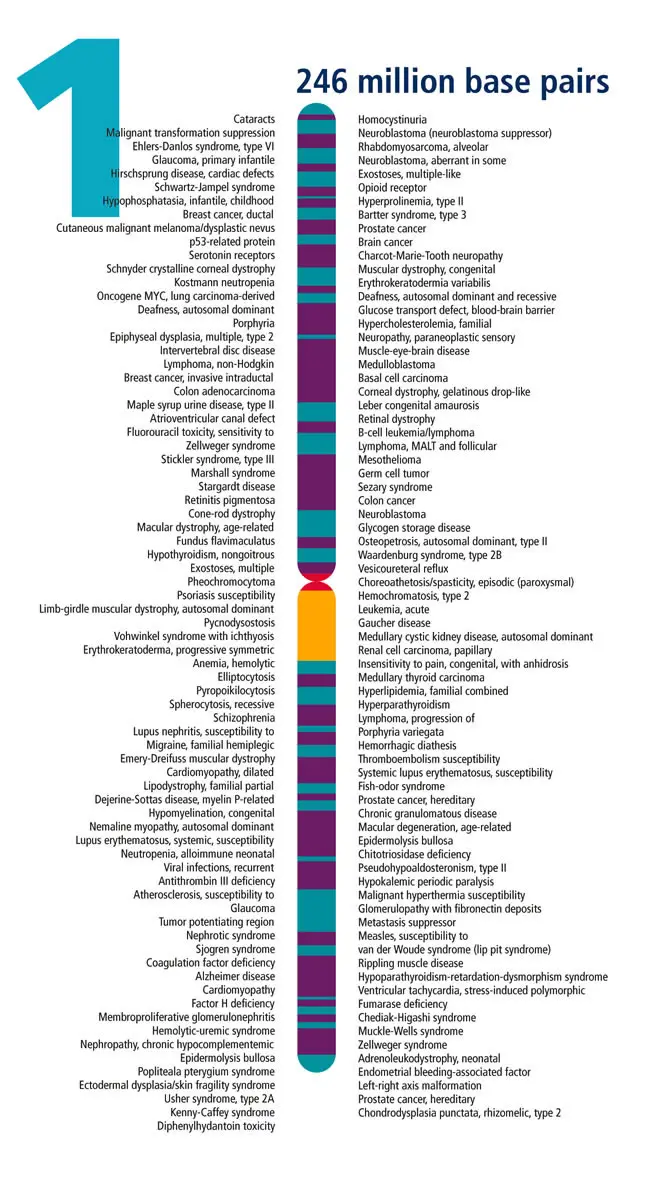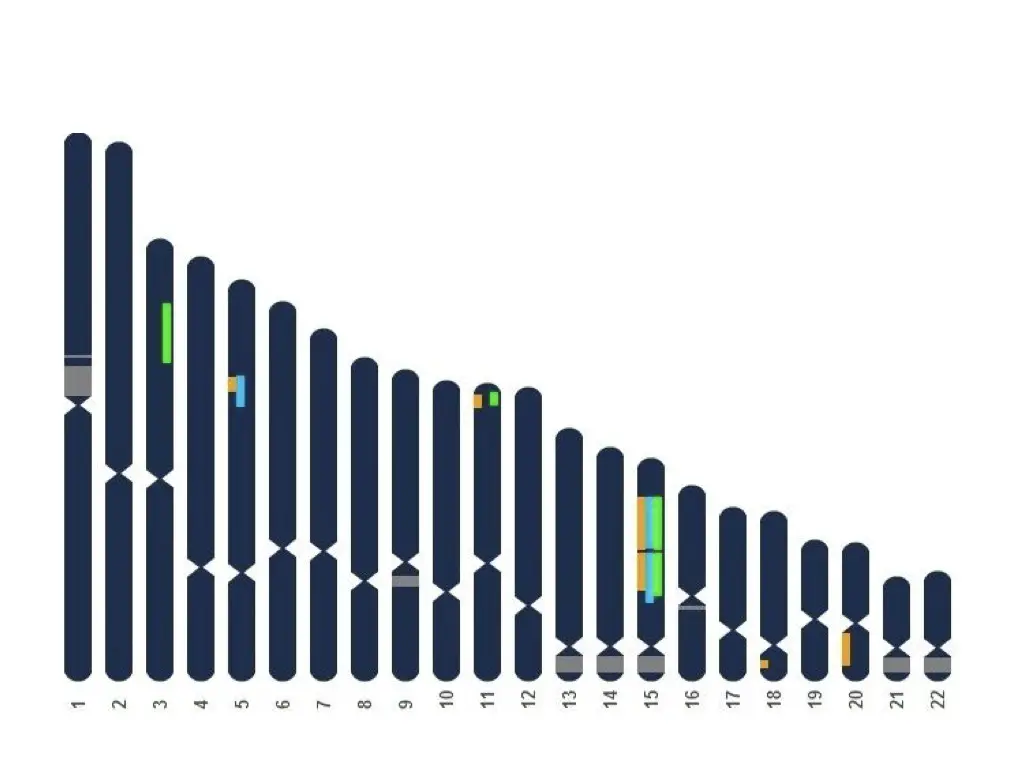“Chromosome 1 is the largest human chromosome made up of around ~8% of total genomic DNA, gene mutations and chromosomal aberration of it are mainly associated with developmental, mental, and psychological problems.”
Entire DNA of us (either coding or non-coding) is located on the chromosomes. The chromosome is a complex network of DNA and proteins which helps in fitting DNA into the nucleus.
23 pairs of chromosomes are present human somatic cell. A haploid set of it is called a genome.
From the 23 pairs, a pair of sex chromosome X and Y decides the gender of a person.
Every chromosome is different in length and structure, however, broadly they are categorised in metacentric, submetacentric, acrocentric and smaller metacentrics.
In the present article, we will give you information about chromosome 1 which is one of the largest chromosomes in human.
Key Topics:
Chromosome 1:
Chromosome 1 is one of the largest chromosomes among the 23 pairs of chromosome present in humans.
It contains approximately 249 million base pairs having 8% of total DNA of our genome.
As per the NCBI total ~2100 to 3141 protein-coding genes, 1.790 non-coding RNA genes and 1,426 pseudogenes are present of chromosome 1.
Structurally, chromosome 1 is a larger metacentric chromosome in which the “p” arm and the “q” arm of the chromosome are almost similar in length.
Approximately 890 to 900 genetic disorders are associated with chromosome 1 in which some are gene mutations and some are chromosomal abnormalities.
Alzheimer’s disease, Gaucher disease and glaucoma are three common diseases associated with it.
As per Gregory SG et al, approximately 350 diseases are associated with chromosome 1. Developmental and mental disorders, neurological conditions and cancer are common among all.
Note: chromosome 1 is six-time longer than chromosome 21, 22 and Y.
From the total DNA of chromosome 1, the “p” arm of it contains 120,405,438bp while the “q” arm contains 103,470,420bp sequences.
The telomeric repetitive sequences are majorly made up of (TTAGGG)n.
Chromosome 1 is more “gene-dense” chromosome as it contains genes per 14.2Mb of DNA.
The genes on chromosome 1 are regulated by the microRNAs, approximately 22 microRNAs are present on chromosome 1.
Total of 800,653 SNPs found on chromosome 1 in which 7,917 in protein-coding genes (4,471 are synonymous and rest are non-synonymous).
Interestingly, 90 SNPs introduced premature stop codon in the coding genes which results in loss of function mutations.
The recombination rate on the ”p” arm is lower as compared with the “q” arm, however, the telomeric regions have higher recombination frequency than the other regions.

Some of the genetic conditions associated with chromosome 1 are enlisted below,
Chromosome 1p36 deletion:
The “p” arm deletion is more common than the q arm on chromosome 1 in which the 1p36 deletion is associated with the cancerous condition called neuroblastoma.
The neuroblastoma is a tumour composed of the neuroblast- a type of nerve cell. It can not be inherited in the consecutive generation because the deletion is somatic in nature.
The region 1p36.1 to 1p36.3 deletion is associated with the more severe form of cancer, however, the size of the deleted segment and severity of the syndrome are not correlated.
Cancer majorly affects the areas of adrenal gland, neck, chest and abdomen.
Besides this, the 1p36 deletion is also associated with a heart defect or cardiomyopathy, intellectual disability and developmental delay.
Chromosome 1q deletion:
The region of the “q” arm- 1q21 is 4Mb is the size. Thrombocytopenia- a genetic condition associated with 1q21.1 deletion.
In this condition, a person has low platelets level.
Apart from this, the 1q deletion is also involved in intellectual disability, developmental delay, mental retardation and psychological and neurological problems.
Alzheimer’s disease:
Alzheimer’s disease is a complex autosomal genetic defect in which many genes are involved. It is a type of chronic neurodegenerative condition in which a person suffering from mild to severe mental and psychological problems.
Mood swing, minor short-term memory loss, sleeping problem and poor thinking ability are a common problem associated with it.
Factor V Leiden:
Factor V Leiden is a type of blood disorder associated with blood clotting which arises due to the mutation in protein C.
Mutations in protein C (CACHD1 gene) causes hypercoagulation results in abnormal and harmful clots in the blood.
Gaucher disease:
Gaucher disease is an autosomal recessive condition arisen due to the mutation in the GBA gene.
It is a type of metabolic condition in which the glucocerebroside cannot degrade adequately. The accumulation of lipid- glucocerebroside affects spleen, kidney, lung and liver functions.
Besides this, hearing loss, Maple syrup urine disease, Parkinson disease and prostate cancer are associated with chromosome 1.
Related articles: DNA • Gene • Chromosome
Conclusion:
Partial trisomy and ring chromosome are also sometimes observed. Deletion is one of the common chromosomal abnormality observed in chromosome 1.
Using conventional karyotyping and FISH chromosome 1 deletions can be detected, although minor deletion can not be detected using the karyotyping method.
For more information on chromosome 1:
- Genome data viewer- chromosome 1
- Atlas of genetics- chromosome 1
- Genes linked with cancer0 chromosome 1
Sources:
Gregory, S., Barlow, K., McLay, K. et al. The DNA sequence and biological annotation of human chromosome 1. Nature 441, 315–321 (2006).


